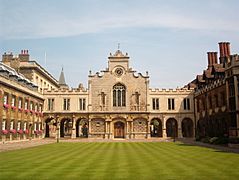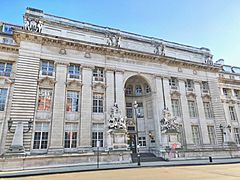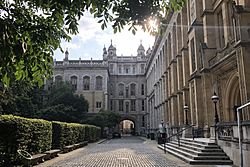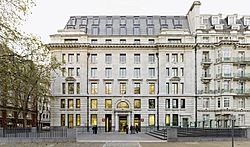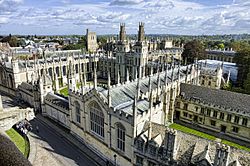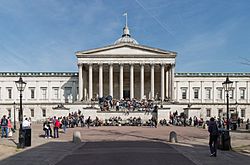Golden triangle (universities) facts for kids
The golden triangle is a special name for a group of top universities located in three cities in the south east of England: Cambridge, London, and Oxford. These universities are known for being very good at teaching and research. Sometimes, people call this group the Loxbridge triangle, which is a mix of London and Oxbridge (a name for Oxford and Cambridge together). If there are only five universities in the group, it's sometimes called the G5.
The exact list of universities in the golden triangle can change depending on who you ask. However, it usually includes the University of Cambridge, the University of Oxford, Imperial College London, King's College London, the London School of Economics (LSE), and University College London (UCL). Sometimes, King's College London or the London School of Economics might not be included. Other times, more universities from these three cities are added.
Contents
Top Universities in the Golden Triangle
The universities often called members of the golden triangle are some of the oldest and most famous in England. They also have some of the largest amounts of money saved up, called financial endowments, which helps them pay for things like buildings and research. In the 2023-2024 school year, the number of students at these universities ranged from about 12,900 at LSE to 51,400 at UCL. UCL is actually the second-largest university in the United Kingdom by the number of students.
| Institution | Year Founded | Motto |
|---|---|---|
| University of Cambridge | 1209 | Hinc lucem et pocula sacra (From this place, we gain enlightenment and precious knowledge) |
| Imperial College London | 1907 | Scientia imperii decus et tutamen (Knowledge is the adornment and protection of the Empire) |
| King's College London | 1829 | Sancte et Sapienter (With Holiness and Wisdom) |
| London School of Economics | 1895 | Rerum cognoscere causas (To Know the Causes of Things) |
| University of Oxford | 1096 | Dominus Illuminatio Mea (The Lord is my Light) |
| University College London | 1826 | Cuncti adsint meritaeque expectent praemia palmae (Let all come who by merit deserve the most reward) |
Research and Funding
These universities, especially Cambridge, Oxford, Imperial, King's, and UCL, get a lot of money for their research. This is called "research income." They are among the top universities in Britain for getting money for research projects. A big part of their research money comes from studying medicine.
In 2013-2014, universities in Oxford, Cambridge, and London received almost half of all the research money in the UK. Some people think this is too much and that the money should be spread out more to other universities across the country. However, supporters say that these universities get more funding because they do a lot of high-quality research.
In 2004, some of these universities (Cambridge, Imperial, LSE, Oxford, and UCL) were said to have worked together to ask the government for more money. They wanted extra funding to help cover the full costs of teaching students from the UK and the European Union. They felt that without this extra money, they might have to take fewer students from the UK.
The UK government has a plan called "Levelling Up" to increase public investment outside of the south east of England. This means they want to give more money to other parts of the country by 2030. Some university leaders are worried this might mean less focus on scientific excellence when deciding where research money goes.
Academics and Students
Getting In: Admissions
The golden triangle universities are very hard to get into. They look for students who have done very well in their exams. For example, in 2022-2023, four of these universities were in the top ten in the UK for how high their entry standards were. This means students needed really good grades to get accepted.
They also have some of the lowest "offer rates," which is the percentage of students who apply that get an offer to study there. For the 2022 undergraduate admissions, all of these universities offered places to less than 40% of the students who applied.
| University | Applications | Offer Rate (%) | Accepted |
|---|---|---|---|
| Cambridge | 21,940 | 24.4% | 3,565 |
| Imperial | 30,725 | 33.1% | 3,135 |
| King's | 69,300 | 38.5% | 6,810 |
| LSE | 26,240 | 20.6% | 1,815 |
| Oxford | 24,230 | 19.7% | 3,260 |
| UCL | 77,615 | 27.0% | 7,595 |
How Universities Are Ranked
These golden triangle universities usually do very well in international university rankings. These rankings often look at how much research a university does. Some rankings adjust for the size of the university, while others don't.
In UK university rankings, Cambridge and Oxford are almost always in the top three. Imperial, LSE, and UCL are usually in the top ten. King's College London is also a very good university, but it doesn't always make the top ten in these specific rankings.
| University | ARWU 2024 (Global) |
QS 2025 (Global) |
THE 2025 (Global) |
Complete 2026 (National) |
Guardian 2025 (National) |
Times/Sunday Times 2025 (National) |
|---|---|---|---|---|---|---|
| University of Cambridge | 4 | 5 | 5 | 1 | 3 | 4 |
| Imperial College London | 25 | 2 | 9 | 6 | 5 | 6 |
| King's College London | 53 | 40= | 36= | 19 | 28 | 24= |
| London School of Economics | 151–200 | 50= | 50= | 3 | 4 | 1 |
| University of Oxford | 6 | 3 | 1 | 2 | 1 | 3 |
| University College London | 15 | 9 | 22= | 13 | 9 | 7 |
Who Goes to These Universities?
Students from Private Schools
Many students at these six universities come from private schools. In 2020-2021, more than 30% of UK students at most of these universities (except King's) had attended private schools. This is higher than the national average, as only about 6% of all school-aged children in the UK go to private schools.
Students from Around the World
These universities also have a lot of students from other countries. For example, in 2023-2024, the London School of Economics (LSE) had the highest percentage of non-UK students in Britain, with 63.7% of its students coming from outside the UK. UCL and Imperial also have a very high number of international students.
| University | British White | British Asian | Black British | British Mixed Heritage |
Other/ not known |
International | |
|---|---|---|---|---|---|---|---|
| EU | Non-EU | ||||||
| Cambridge | 45.3% | 11.3% | 2.7% | 5.4% | 3.1% | 6.9% | 25.3% |
| Imperial | 20.5% | 18.4% | 2.6% | 3.5% | 4.1% | 9.9% | 40.9% |
| King's | 27.7% | 18.7% | 6.2% | 4.3% | 5.1% | 5.9% | 32.0% |
| LSE | 16.0% | 11.9% | 2.4% | 3.3% | 2.8% | 12.7% | 51.0% |
| Oxford | 45.5% | 7.6% | 2.1% | 4.7% | 3.4% | 8.3% | 28.4% |
| UCL | 23.5% | 13.6% | 3.3% | 3.8% | 3.6% | 6.6% | 45.7% |
| England | 81.0% | 9.6% | 4.2% | 3.0% | 2.2% | N/A | N/A |
| 82.6% | 6.3% | 11.1% | |||||
Gallery
- Golden Triangle (Universities)
-
Imperial College London
(Royal School of Mines) -
King's College London
(Maughan Library) -
London School of Economics
(New Academic Building) -
University College London
(Wilkins Building)
See also
 In Spanish: Golden triangle para niños
In Spanish: Golden triangle para niños
- Ivy League (older private universities in the United States)
- Imperial Universities (Japan)
- C9 League The Chinese Ministry of Education's formal grouping of elite universities in China
- SKY (universities) (Korea)
- Institutes of National Importance (India)
- National Institutes of Technology – 30 leading public engineering universities in India
- Research-intensive cluster
- Global Medical Excellence Cluster
- MedCity (London)
- Russell Group A formal grouping of research universities in the UK
- SES-5 A formal grouping of universities in the South East of the UK
- Group of Eight A formal group of eight universities in Australia
- Doxbridge, a portmanteau for a combination of Oxbridge and Durham University
- Ancient universities Oxbridge, Scottish, and Irish Universities formed before the year 1600 with unique undergraduate MA awarding powers


